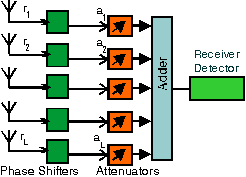
Diversity Reception
A signal transmitted at a particular carrier frequency and at a particular instant of time may be received in a multipath null. Diversity reception reduces the probability of occurrence of communication failures caused by fades by combining several copies of the same message received over different channels. In general, the efficiency of the diversity techniques reduces if the signal fading is correlated at different branches.

Figure: L-branch antenna diversity receiver (L = 5)
Methods for obtaining multiple replicas
- In antenna (or micro) diversity the signal from antennas mounted at separate locations are combined. Typically these antennas are located on the vehicle or at the same base station tower and their spacing is a few wavelengths. The received signal amplitude is correlated for antennas separated by a distance d. The received multipath signal becomes practically uncorrelated if antennas at the mobile are spaced by more than, say, half a wavelength.
In the analysis of this correlation, it was assumed that the mobile antenna is mounted at low height and close to all kinds of reflecting and scattering objects. The base station antenna however, is mostly located well above such obstacles. Hence at the base station all multipath waves arrive from approximately the same direction. If the antenna is moved over a certain small distance d, the phase shift is almost identical for all arriving waves. This is in sharp contrast to the situation at the mobile where motion over half a wavelength leads to almost uncorrelated signal phases. To ensure effective antenna diversity at the base station, antennas must be separated much farther than the fraction of the wavelength required for diversity at the mobile.
- In site (or macro) diversity the receiving antennas are located at different receiver sites. For instance, signals from within a cell may be received at the different corners of the hexagonal area. The advantage is that not only the multipath fading attenuation is independent at each branch but that the shadowing and path losses are also uncorrelated to some extent.
-
Polarization diversity exploits the fact that obstacles scatter waves differently depending on their polarization. In angle diversity, directional antennas receive only a fraction of all scattered energy. It is hoped that in (at least) one of the branches the received waves do not cancel each other, resulting in a relatively strong signal.
-
In the above diversity schemes, only one copy of the message is transmitted but uncorrelated fading for at different receive antennas is exploited. In contrast to this, in frequency and time diversity, the same message is transmitted more than once, respectively at different carrier frequencies and different instants of time. In frequency diversity the difference in carrier frequency should be more than the coherence bandwidth to achieve effective diversity. Digital cellular system can use slow frequency hopping (SFH) for diversity reasons: each block of bits is transmitted at a different carrier frequency.
- In time diversity, the time difference between two transmissions should be large compared to the time is takes the mobile antenna to move half a wavelength. In systems with stationary antennas, such as indoor wireless communication, time diversity will be less effective as the channel characteristics do not change very much with time. However, time diversity may be helpful if uncorrelated interference signals are experienced during successive attempts.
Selection Methods
Various techniques are known to combine the signals from multiple diversity branches.
 Video
Video
Signal Processing for diversity reception
How to combine the the signals received via multiple antennas?






|



 Video
Video